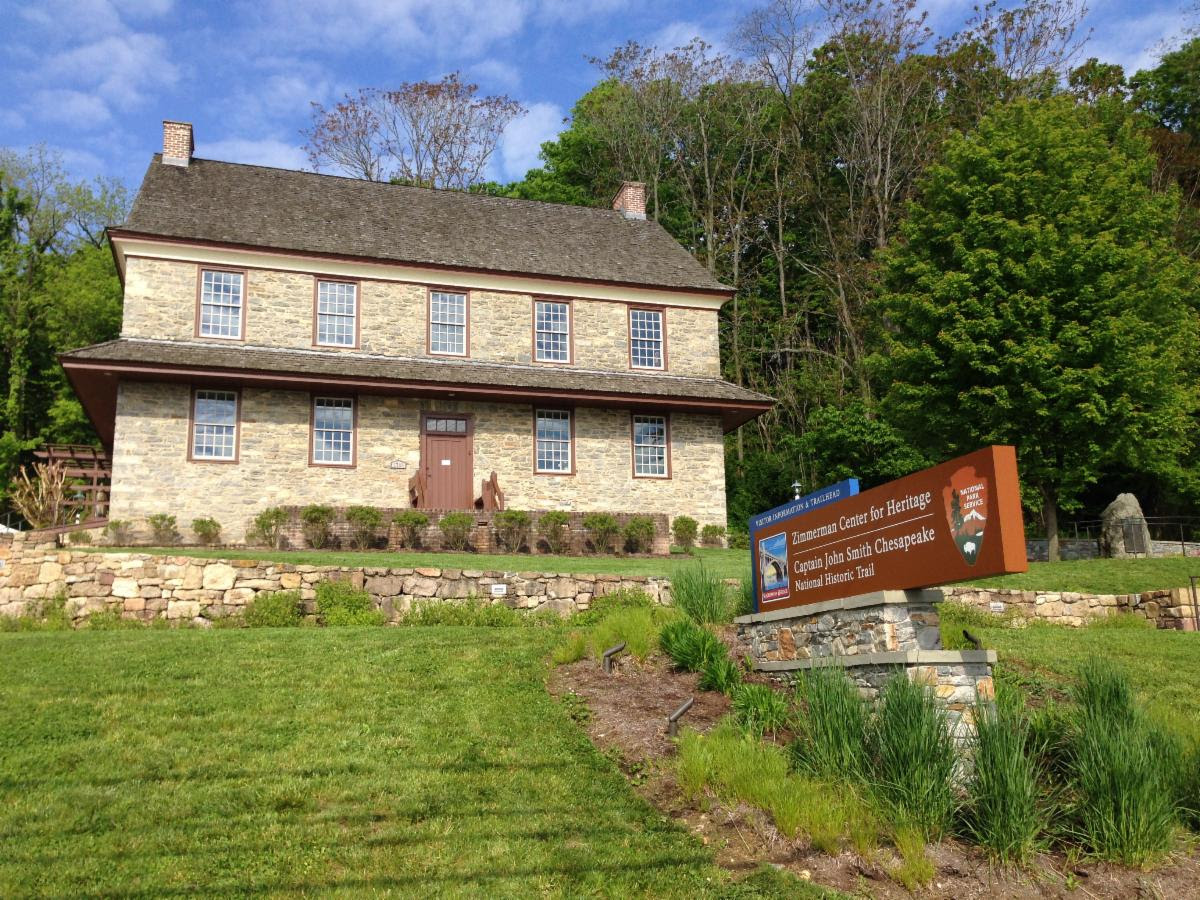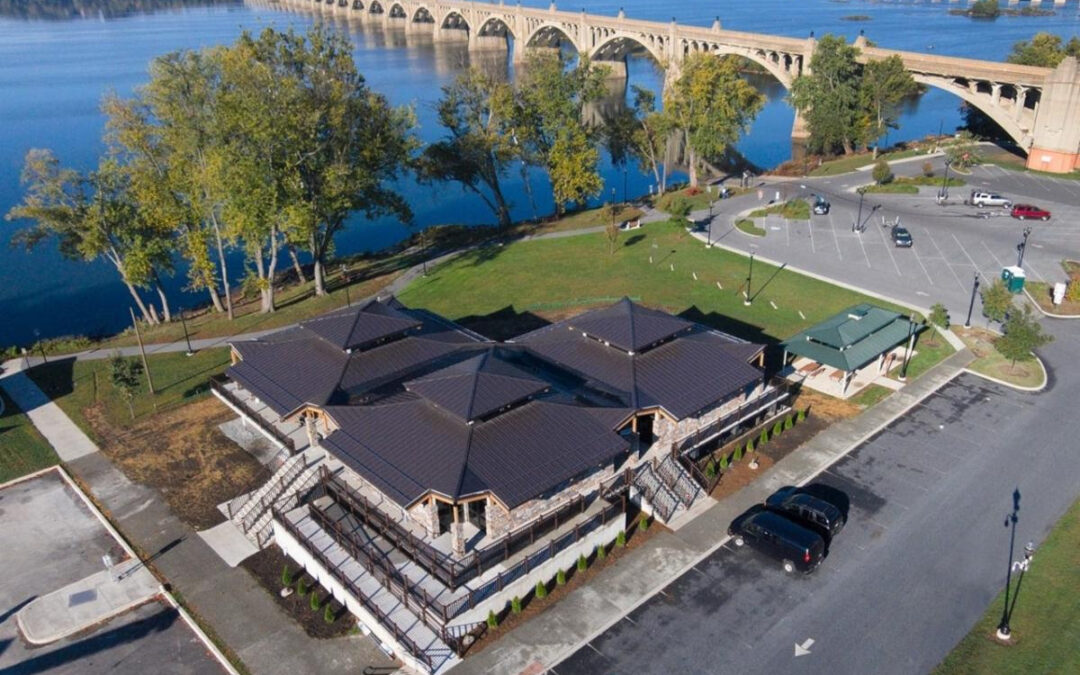Columbia Crossing River Trails Center: An aerial shot overlooks the Columbia Crossing River Trails Center which stands along the shoreline of the Susquehanna River in Lancaster County, Pennsylvania. Photo credit: Susquehanna National Heritage Area
Written by Warren Brown
More than 40 years of work to develop, refine and institutionalize creative approaches to partnerships for resource conservation came to fruition in December 2022, when Congress took what was described as “a bold, bipartisan step” to protect America’s heritage: enactment of the National Heritage Act. The Act – a remarkable display of agreement across political boundaries – received 426 favorable votes across both chambers of Congress, with 100% support in the United States Senate and 77.4% in the House of Representatives. This reflected support for the protection of not only historic resources but the natural landscapes that surround them.
In case you don’t remember the late 1970s and early 1980s, a lot of public discourse focused on the “sagebrush rebellion” that sought to get the federal government out of the business of managing federal lands and turn them over to state or local control. Parallel pressures sought to relax regulations to protect the environment at all levels of government. The priority for many in Congress was to facilitate private development and industrial activity. At the same time, conservationists were pursuing ideas about parks where the federal role would be reduced in favor of local leadership.
The Illinois and Michigan (I&M) canal played an enormous role in the development of the nation by connecting Chicago to water routes south to New Orleans and east to New York. The 96-mile-long canal opened in 1848 through a corridor that encompasses important habitat for migratory birds as well as the history of Indigenous people, French fur traders, nineteenth-century pioneers, canal traders and modern shipping industries. Searching for a new way to recognize and protect the canal corridor led to a new idea: the National Heritage Corridor, an innovative designation that relied on National Park Service technical and financial assistance rather than direct management of visitors and resources. The heritage area designated in 1984 encompasses 862 square miles, including five counties and 60 communities that all owe their growth to the I&M Canal.
In the years since 1984, there have been 62 more National Heritage Areas (NHAs) designated. Almost all of this growth has been without the benefit of a consistent formula of how the areas will be managed, protected and funded. Now, with NHAs being recognized by Congress as a system, there is good reason to hope they will be recognized as a valued implement in the conservation toolbox and a complement rather than a competitor for national park funding.
NHAs can be considered to be a different formula for protecting resources or creating new parks. They also might be better described as a way well suited to protecting a different type of resource: a large and living landscape where people reside and work, where cultural traditions persist, and humans are part of the ecosystem with an economy that reflects the area’s distinctive history.
NHAs are usually not directly engaged in land protection as the NHA Act includes specific disclaimers about impacts on private property rights, land use regulations and public access. However, identifying important resource values, planning and implementation of a NHA can build public support for independent conservation initiatives by states, local governments and the private sector.
For example, the Susquehanna National Heritage Area was designated in 2019. It is one of a few NHAs located in the Chesapeake watershed, and it is a member of the Chesapeake Conservation Partnership. Susquehanna NHA works with partners and communities to advance a vision for the Susquehanna River and the region as a national destination for heritage and outdoor travelers. Typical of NHAs, planning for the Susquehanna has focused on tourism development to increase the visibility and readiness of the area as a visitor destination and placemaking initiatives to enhance the quality and appeal of special places and landscapes.

The Zimmerman Center for Heritage stands along the shoreline of the Susquehanna River in York County, Pennsylvania. This center interprets the history of the Susquehannock Indians, provides access to nearby Native Lands Park and serves as the headquarters of the Susquehanna National Heritage Area. Photo credit: Susquehanna National Heritage Area
The Susquehanna NHA manages two places for visitors to discover the river’s rich cultural and natural heritage –the Zimmerman Center for Heritage and Columbia Crossing River Trails Center. The NHA:
- Provides maps and guides to help visitors find and explore the river’s extensive network of parks, preserves, trails and heritage sites;
- Leads a coalition of tourism, business and public partners to enhance economic vitality through heritage and outdoor tourism development;
- Collaborates with the National Park Service to develop and implement a Segment Plan for the Lower Susquehanna portion of the Captain John Smith Chesapeake National Historic Trail (Chesapeake Trail), the nation’s first water-based national historic trail; and
- Supports regional initiatives to save and enhance important and iconic river landscapes for public use and benefit.
The 2022 National Heritage Area Act also authorized new NHAs in southern Maryland and the northern neck of Virginia.
Heritage areas have been the subject of rigorous analysis of their economic and other impacts. At the request of Congress, the National Park Service commissioned a series of evaluations reviewing the accomplishments of 12 of the earliest designated NHAs. These evaluations found each of these NHAs is meeting the goals identified in its authorizing legislation through dynamic partnerships and is leveraging its NPS funding by as much as a ratio of five to one (5:1). NPS funds were identified as the consistent and flexible seed money for projects and programs.
NHAs have sought to take a strong role in addressing diversity, equity and inclusion: Sara Capen, chair of the Alliance of National Heritage Areas, noted that initial advocacy for NHAs focused on their economic contributions, but now NHAs are recognized as
“places that tell a rich and diverse American story. Behind monuments and portraits is a legacy that is much more complex. National Heritage Areas empower people to tell their stories in their words within the framework of their American experience. Through our collective efforts, we remind our neighbors and visitors that history is never ‘long ago and far away’ but an arc to today where the impact of history still lives on in communities. National Heritage Areas preserve, protect and share difficult stories that every American should be required to know.”
The Chesapeake Bay currently benefits from many of the activities by NPS that characterize NHAs, including planning, grants and technical assistance. NHAs operating throughout the nation can benefit from sharing their experiences with NPS and other partners in the Chesapeake.
Written by Warren Brown. Brown had an illustrious career with the National Park Service, including as the Chief of Park Planning and Special Studies, and is now mostly retired.
Lightning Update is a regular communication of the Chesapeake Conservation Partnership. Any opinions expressed are those of the authors and do not necessarily reflect positions of the Partnership or member organizations.
To share a success story, news, or important event, send your information to:
Support for the Chesapeake Conservation Partnership is provided by:
National Park Service Chesapeake
EPA Chesapeake Bay Program
USDA Forest Service
Pennsylvania Department of Conservation & Natural Resources
Maryland Department of Natural Resources
Virginia Outdoors Foundation
US Fish & Wildlife Service
Chesapeake Conservancy
The Chesapeake Conservation Partnership is co-convened by:




